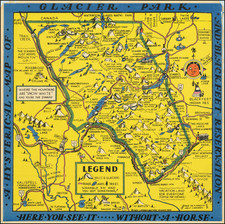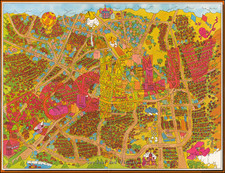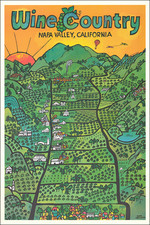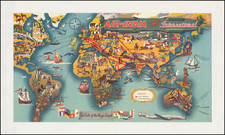Whimsical Map of Johns Hopkins by American Editorial Cartoonist Richard Q. Yardley
A marvelous whimsical / pictorial map of Johns Hopkins Hospital, credited below the vignette of the front of the hospital with "Yardley drew this".
The map includes comical illustrations in a 1930s cartooning style throughout, including a doctor looking at an x-ray of a woman's torso, a surgeon about to operate on a startled patient with a knife, a stork delivering a baby, the Wilmer Eye Clinic, and the Animal House (presumably where animal experimentation for medical research takes place) where one monkey examines another.
A portrait of Johns Hopkins, "Baltimore Banker and Philanthropist born in 1795 and founder of the hospital that bears his name," appears in the lower left. Pictorial illustrations of neighborhood businesses on the map also appear in the border. The compass rose bears an "Rx" symbol in the center.
Some of the map's content is a bit off color, including a note "Here ye Beauteous Nurses do Reside", two nurses chatting with the phrase "Did you come to get or forget," and a vignette at the top center entitled Public Health, with a doctor handing a bar of soap to a dark bathing suit clad woman. In the middle, above the "Public wards" is a backfaced patient with the phrase, "Dat Razor Was Sho Sharp! Yes Suh!" At the bottom, to the right of the primping nurse, a blackfaced man is in a donkey cart, pulling watermelons, with the captions "A Bit of Old Baltimore."
At the center, a female nurse receiving her diploma (nursing degree) is noted as "Bright Girl."
In all a fabulous and rare object.
Richard Q. Yardley
Richard Quincy Yardley (1903-1979) was an American editorial cartoonist.
Born in Baltimore, Maryland on March 11, 1903, Yardley attended the Friends School and the Maryland Institute. Yardley started as an artist-retoucher in the news department at the Baltimore Evening Sun in 1923 and moved into creating local news and commentary cartoons in 1934, for the Morning Sun.
In 1949, he became the Sun's editorial cartoonist after Edmund Duffy's retirement. From 1961 until 1965, Yardley also drew the daily comic strip panel, Our Ancestors, which was syndicated by the Newspaper Enterprise Association. In addition to these works, his cartoons appeared in the New Yorker and the Reporter. Yardley was a member of the National Cartoonists Society, the American Association of Editorial Cartoonists and the National Press Club.
Richard Q. Yardley (1903-1979) was an American editorial cartoonist.
Born in Baltimore, Maryland on March 11, 1903, Yardley attended the Friends School and the Maryland Institute. Yardley started as an artist-retoucher in the news department at the Baltimore Evening Sun in 1923 and moved into creating local news and commentary cartoons in 1934 for the Morning Sun.
In the late 1930s, Yardley drew several provacative pictorial maps for the anti-Fascist Ken Magazine.
In 1949 he became the Sun’s editorial cartoonist after Edmund Duffy’s retirement.
From 1961 until 1965 Yardley also drew the daily comic strip panel, Our Ancestors which was syndicated by the Newspaper Enterprise Association. In addition to these works, his cartoons appeared in the New Yorker and theReporter. Yardley was a member of the National Cartoonists Society, the American Association of Editorial Cartoonists and the National Press Club.
Richard Q. Yardley retired in 1972 and died on November 25, 1979.
The Richard Q. Yardley Cartoons collection at Syracuse University consists of 43 original political cartoons and 2 copies of cartoons. Twelve cartoons are dated and 31 cartoons are undated. One of the cartoons is signed, "W. Hogarth Yardley" and it is unknown if this cartoon was drawn by Richard Q. Yardley. Satire and sarcasm were regularly used elements in Yardley’s cartoons.
The cartoons were drawn with ink on illustration board as well as paper with traces of blue pencil visible. The cartoons vary in size.










![The Monterey Peninsula California Pinto Guide Map to Fine Accommodations Restaurants Theatres Services Shops [double sided map]](https://storage.googleapis.com/raremaps/img/small/102769.jpg)



![[Senegal / Safaris / Railroads] Chemins de Fer du Senegal](https://storage.googleapis.com/raremaps/img/small/88789.jpg)